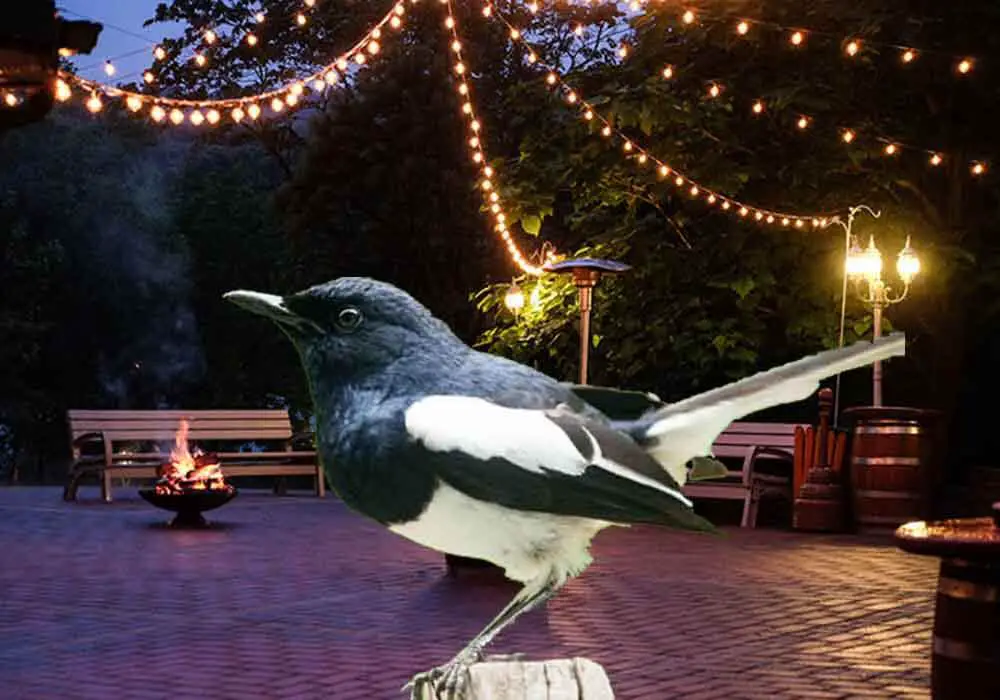How To Keep Birds Away
From Plants
These 7 Helpful Tips Will Help You Regain Control
Attracting birds to the garden is a lot easier than keeping them out. A flowering garden will bring the birds to the yard–and so will a vegetable garden. Understandably, vegetable gardeners aren’t as hospitable to our avian friends as flower gardeners. What you'll learn here is how to keep birds away from plants.
Putting physical barriers such as netting, chicken wire, garden fleece, and stick barriers are effective deterrents to birds. They can prevent birds from wreaking havoc on your crops as well as keep them from contaminating garden produce with bird droppings.
If your garden plants are constantly under siege, keep reading until the end of this article to learn how you can mount harmless countermeasures that will keep the birds away from your vegetables.

1. Defend Your Greens With Butterfly Netting
Butterfly netting keeps birds away while allowing beneficial insects access to your plants for pollination. Netting like the Faraer Plant Covers (available on Amazon.com) has an ultra-fine mesh netting that prevents birds from getting stuck and injured while allowing air and moisture to reach your plants.
The material is UV-resistant and can be used for years or even a lifetime, whereas cheaper alternatives can fray and fall apart. Butterfly netting is also non-toxic, can be safely used to deter birds, and will not harm butterflies or other beneficial insects.
2. Protect Your Plants With Chicken Wire
Physical barriers are an effective deterrent to pest birds. They are chemical-free and aren’t harmful to birds. However, they aren’t a favorite option of most gardeners because of the work of putting them up. Not to mention they can take away from the garden’s natural aesthetic.
Nevertheless, they are used because of their effectiveness and practicality. One such physical barrier is chicken wire. Chicken wire is ideal for protecting newly-sown seeds or tubers from birds. It keeps birds from scratching and pecking at the soil.
As seedlings start to grow, the chicken wire will need to be adjusted and lifted off the ground, and then suspended on stakes. This allows the seedlings to grow while still providing protection from opportunistic birds just waiting for their moment to spring on the seedlings.
3. Improvise Defenses With Garden Fleece
Garden fleece is a thin white material that is usually used to protect plants from frost or the biting cold. However, gardeners use them as a barrier to keep birds from their greens. The material is simply draped over the plants and weighed down with rocks or pegs to keep it from being blown or carried off by the wind.
The Reusable Floating Row Cover (available on Amazon.com) is an excellent example that keeps out birds and prevents destructive bugs from feeding on the plants. While its primary purpose is to insulate plants from harsh cold temperatures, it can also be used to shield them from the merciless sun during sweltering weather.
In the spring and summer, garden fleece is often spread out to deter birds from harvesting your garden plants before you can. The material is durable and can be reused as long as they are stored properly. They can be bought in varying lengths that you can custom cut to the size you need for your garden.
4. Create a Barricade of Stick Barriers
Another practical line of defense to fortify your garden from pest birds is stick barriers. Pushing sticks and twigs into the ground around your seedlings will make the ground look like dangerous terrain that would make any bird think twice about attempting a landing.
Most birds wouldn’t risk it and move on to your neighbor’s garden. However, this defense strategy isn’t without its downsides. Putting up a stick barrier can be time-consuming and could become problematic when it comes time to harvest. how to keep birds away from plants
This method is usually only utilized for young seedlings. When your seedlings reach a particular stage, you will have to find an alternative way to keep the birds away from your plants. Needless to say, when the time comes, you will have to get on all fours to pick out the sticks.
5. Plant Protective Flowers
If physical barriers don’t fit into the garden aesthetic you are going for, a great alternative would be to plant various annuals around your garden patch. Excellent examples are:
- Calendulas
- Nemophila
- Cornflowers
- Field poppies
They not only add a splash of color and are pleasing to look at but also discourage pigeons and other pest birds from descending on your garden patch. This is because these birds are wary of lush flowery growths that may conceal predators.
6. Fortify With Bird Scare Tactics
Physical barriers may not be enough to keep your garden pest bird-free. And as I mentioned earlier, physical barriers aren’t everybody’s cup of tea when it comes to visual appeal. Most people prefer a garden that isn’t concealed from view with netting and fleece.
Alternatively, you can keep the birds away by scaring them. There are many non-lethal scare tactics that can keep birds away without harming them. You can use these scare tactics alongside your physical barriers for that added measure of deterrence.
Here are some scare tactics that might do the trick:
- Terror Eye Balloons. Terror eye balloons are made of reflective Mylar material. The eye mimics the glare of a predatorial bird locking in on its prey and strikes fear into the hearts of pest birds. Different versions work for different bird species.
- Scarecrows. Scarecrows are a time-proven way to deter birds. Scarecrows with a swivel mechanism that allows them to move when the wind blows are even more effective.
- Toy Predators. Toy predators can even be scarier than scarecrows. Some birds have become desensitized to humans, and a scarecrow looks like a human. However, they are programmed by instinct to always be afraid of birds of prey.
- Reflective Devices. Birds dislike reflective surfaces. So reflective bird scare tape, reflective danglers, and reflective pinwheels can annoy birds away from your garden.
- Electronic Bird Repellers. Electronic bird repellers emit sounds that most pest birds find threatening, such as predator sounds.
7. Hang Some Wind Chimes
Birds are really skittish about things that make sudden sounds or movements. Enter wind chimes. I mention them separately because they aren’t primarily for scaring birds. They are meant to be decorative. But since they inadvertently have some bird scare value, we will mention them here.
Even the slightest wind can set a wind chime off and scare the droppings out of a bird setting its sights on your cabbage patch. However, for this to work, your wind chimes would have to be strategically placed where they can be perceived as a threat. A wind chime hanging from your porch is a no-go.
Hang several wind chimes in strategic places to optimize their efficacy. The more colorful they are, the harder the birds will tremble. I’ve mentioned that birds don’t like reflective surfaces, so reflective wind chimes are a double kill that might instill more fear than a catatonic scarecrow wearing hand-me-downs.
How To Keep Birds Away From Plants...
Final Thoughts
You can keep birds away from your plants by using physical barriers to hinder access to your precious greens. However, some birds can be pretty relentless, and you will need to get creative by using a combination of barriers as well as non-lethal scare tactics that will keep birds from harvesting your greens and contaminating them with bird droppings.
Back To The TOP Of This How
To Keep Birds Away From Plants Page

About the Author...
Richard Worden, a dedicated bird lover for over 20 years, I love to share my in-depth knowledge and passion for birds. Read more About Me and my expertise in this field.
- We Know Birds HOME ›
- How To Scare Away Birds From Your House Or Garden ›
- How To Keep Birds Away From Plants



